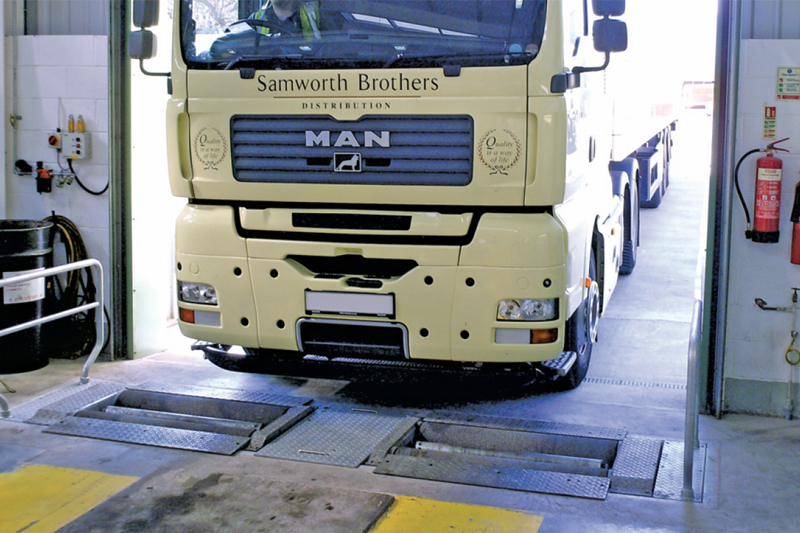
Investing in a roller brake tester is a big commitment but it still costs substantially less than buying a new truck and it can play a vital role in protecting your OCRS score, says VL Test Systems.
Annual test failures are recorded in the roadworthiness section of a fleet’s Operator Compliance Risk Score file. Too many first-time failures can mean operators slip from green to amber or even amber to red. Using the test itself to discover if there are any roadworthiness faults that need fixing has therefore become a risky strategy and more operators are focused on achieving high first-time pass rates.
Brake performance failure remains a top cause of vehicles not achieving a first-time pass, so it is a sensible precaution to carry out a pre-test brake check. If you are an independent workshop, you will want reassurance that the OCRS score is not being adversely affected by low first-time pass rates when you submit vehicles for test. VL Test machines will give you a pass/fail print-out identical to the one you would receive at a DVSA station and you can show that to your customers.

Buyer’s tips
- Check the equipment meets DVSA specifications for RBTs used in either DVSA stations or at ATF test lanes. The roller width and diameter are particularly important criteria as this can affect results.
- Consider the vehicles you will be testing – 3.5- tonne vans? 44-tonne tractor units? All VLT machines are approved in standard format for Class IV, V, VI, VII, HGV and trailers.
- Don’t under-specify. VLT builds to a minimum 16,000 to 20,000kg axle weight to ensure the equipment does not work continuously at the top of its capability. Equipment which is used constantly at its maximum capacity puts extra stress on the machine which can result in unplanned breakdowns and higher service costs.
- An axle weighing system will help deliver predictable results. An axle load simulator is not required unless applying for ATF status. Ideally, a vehicle should be loaded to 65% of its GVW for a brake test, although most will probably pass the brake test at the point of wheel lock. If you are using your RBT for pre-MOT brake checks and relying on wheel lock to pass, remember that the same conditions may not be replicated on the RBT used at the test facility, which can result in an unexpected test failure, especially for those vehicles that are borderline. (All VLT RBTs will give a pass or fail in the vehicle as it is being presented).
- Ask whether the system stops the RBT rollers turning when it registers wheel lock during the brake test. Automated wheel lock recognition and stop helps prevent tyre damage.
- Opting for infrared or wireless connectivity between the hand control and the display console allows the tester to carry out the test from the vehicle – it speeds up testing and there’s no need for a second person.
- Check there is adequate space. The actual equipment needs a space approximately 4,000 by 1,000mm. For installation you will need a substantially level area in front and behind the RBT to accommodate the length of the longest vehicles you wish to test. An inspection pit is only necessary if you have a full ATF lane, although it can be useful to have a pit in the locality of the RBT so that adjustments can be easily made.
- Don’t forget the power supply and requirements. VLT machines work off a 63amp 3-phase Earth and Neutral supply and feature soft-start for less power consumption.
- A play detector is only required for ATF lanes, but can be a useful diagnostic tool as it replicates wheel suspension, king pin movement by moving the wheel/tyre in different directions to show excessive movement.
- Do consider buying the DVSA vehicle database even if you are not applying for ATF status. Presenting brake results in the DVSA format is beneficial for both independent and in-house workshops – any pass/fail printout will be identical to that at the official test and include all the officially required data such as front wheel allowance, lock allowances, trailer rules and so on. A standard RBT will test all items that the machine with the DVSA database tests, but it may not compute or present the results in the recognised format.
- Do make sure the RBT computer has sufficient capacity to store all the data. A VLT machine will store the data in its own CPU (central processing unit) PC and can automatically download data to a PC. VLT recommends that the data is downloaded regularly so that test records are secured in case of unforeseen circumstances in the workshop, such as fire or flood.
- Don’t forget to factor in routine maintenance and calibration. For ATF lanes, the minimum requirement is every six months, but regular service and maintenance can prevent costly breakdowns and time delays. VLT offers fully inclusive maintenance packages with servicing done by company engineers.








